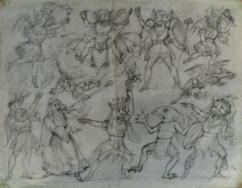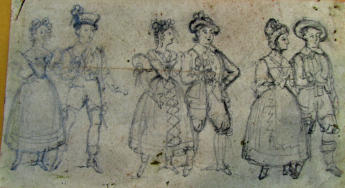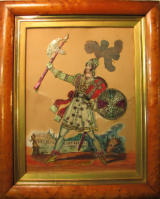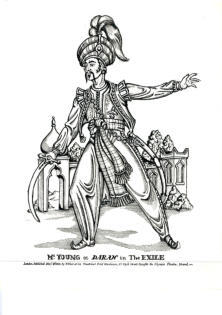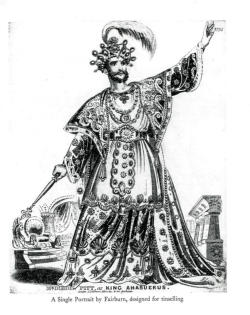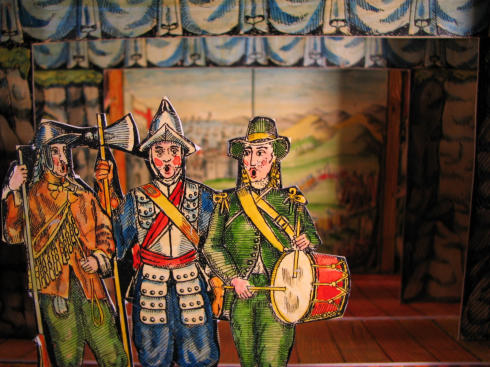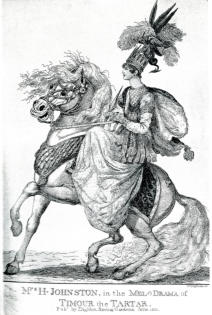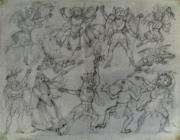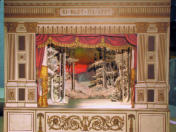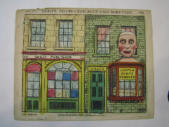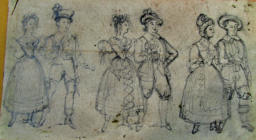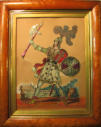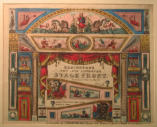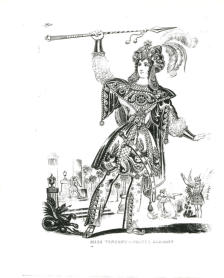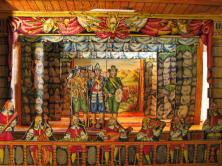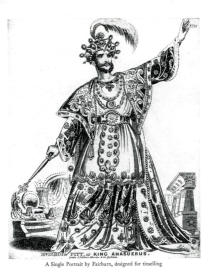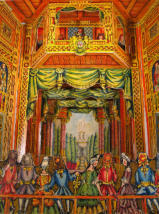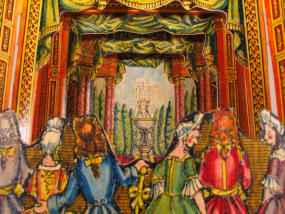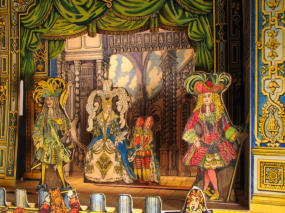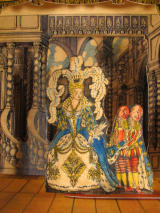NAVIGATION
SOCIAL
CONTACT
e-mail: info@theworldthroughwoodeneyes.co.uk


Toy Theatre
A PENNY PLAIN AND TWOPENCE COLOURED
A
Penny
Plain
and
Twopence
Coloured
was
a
catch
phrase
penned
by
the
Scottish
writer,
Robert
Louis
Stevenson
in
1884,
the
result
of
his
childhood forays in Leith Walk, Edinburgh, and his love of the toy theatre, and his obsession for collecting the miniature theatrical wonders.
Stevenson
wrote
his
essay
first
in
The
Magazine
of
Art‘,
and
later,
in
1887
published
in
his
book,
‘Memories
and
Portraits‘.
The
origins
of
the
phrase
was
based
on
the
fact
that
the
sheets
of
characters
and
scenery
published
for
the
toy
theatre
cost
one
penny
plain
and
two
pence
hand-colourcd.
It
was
the
melodramas
of
the
Romantic
Period
that
inspired
so
many
of
the
most
popular
toy
theatre
plays.
and
it
was
the
melodramas
that
inspired
the
young
Stevenson
as
a
young
writer.
Pirates,
rogues
and
villain’s,
combats,
and
the
fantasy
world
of
pantomime
were
the
stuff
of
the toy theatre, and there it all exists in Stevenson’s ‘Treasure Island’,
In
1811
William
West
produces
a
sheet
of
the
principle
characters
from
the
first
production
on
the
London
stage
of
‘Mother
Goose’,
with
Joseph
Grimaldi
in
one
of
his
most
celebrated
roles
of
Clown.
The
popularity
of
this
role
led
to
the
publication
of
sets
of
sheets
of
characters,
scenery
and
props,
also
elaborate
prosceniums,
the
designs
based
on
those
of
popular
London
theatres.
Books
of
words,
abridged
versions
of the most popular melodramas and pantomimes to be seen on the London stage.
From
this
time
the
popularity
of
the
toy
theatre,
also
known
as
the
‘Juvenile
Drama’,
saw
the
rapid
growth
in
the
number
of
publishers
producing
versions
of
plays,
with
the
drawings
for
the
engravings
made
by
such
leading
artists
as
George
Cruickshank
and
William
Blake.
The
legacy
of
the
19th
century
toy
theatre
is
that
of
the
most
complete
documentation
of
the
costumes,
scenery,
and
the
performance
style
of the actors of the London Theatres of the period.
It
is
generally
accepted
that
the
height
of
the
popularity
of
the
toy
theatre
was
during
the
19
th
century,
even
so,
repeats
of
the
early
plays
continues
to
the
present
day.
Stevenson
was
not
the
only
Scottish
writer
to
contribute
to
the
subject,
Sir
Walter
Scott,
and
numerous
other
well known men of letters include W.B Yeats, Gordon Craig, C.J. Chesterton and others.
No longer can the sheets be bought for pennies, they are now much sought after antiquarian objects of desire, and of great value.
Peter Jackson’s Toy Theatres
Toy
theatre
enthusiasts
will
be
familiar
with
the
elaborate
toy
theatres
created
by
Peter
Jackson.
Peter
was
born
in
1937
and
worked
as
stage
manager
for
West
End
and
other
theatres;
he
was
also
a
manager
and
director
in
a
number
of
regional
theatres.
I
first
met
him
when
he
was
teaching at the Birmingham School of Speech Training and Dramatic Art in Birmingham where I taught the puppet theatre courses.
The
Peter
Jackson
Archive
of
Toy
Theatres
has
been
acquired
for
The
World
through
Wooden
Eyes,
this
archive
includes
all
of
the
well
known
toy
theatres
that
were
published,
plus
others
that
were
never
published.
The
archive
consists
of
hundreds
of
the
original
pen
and
ink
drawings
that
include actor portraits, some of them fine copies of early sheets by other publishers.
Perhaps
the
most
interesting
items
are
his
original
pen
and
ink
drawings
for
all
of
the
toy
theatres,
also
the
hand
coloured
cut-outs
of
the
theatres
that have been assembled, obviously the initial prototypes for printing.
The
theatres
that
were
never
published
are
of
particular
interest.
His
version
of
Tchaikovsky’s
‘Sleeping
Beauty’,
based
on
the
designs
of
Leon
Bakst
for Diaghilev’s 1921 production in London.
The
prototype
theatre
is
hand
coloured
and
has
been
assembled;
there
is
an
acting
text.
There
are
56
exquisite
original
pen
and
ink
drawings
of
characters
and
scenery
that
perfectly
reflect
the
style
and
detail
of
Bakst’s
original
work.
There
are
also
a
number
of
alternative
prosceniums.
Bakst
revolutionised
theatre
design
and
fashion
in
the
early
1900’s.
He
inspired
many
designers,
including
myself.
This
toy
theatre
was
sadly
never
published.
‘The
Siege
of
Rhodes’
by
Sir
William
Davenant
was
adapted
by
Peter
for
the
toy
theatre
version.
The
proscenium
arch
and
perspective
scenes
were
based
on
the
designs
by
John
Webb
for
the
first
performance
at
Rutland
House,
London
in
1656.
The
prototypes
theatres
are
cut-out,
coloured
by
hand, and have been assembled. There are 23 sheets of original pen and ink drawings for the theatre, characters and scenery.
‘Restoration
Theatre’
is
a
working
model
of
the
Dukes
theatre
in
Dorset
Gardens
1671-1709.
There
are
characters
and
scenery
for
‘The
Rehearsal’
by George Villiers Duke of Buckingham. All hand painted and with 14 sheets of original pen and ink drawings. This was never published.
The
archive
has
copies
of
his
published
toy
theatres
and
all
of
the
original
pen
and
ink
drawings
for
theatres,
characters
and
scenery.
There
are
vast
number
of
later
toy
theatre
sheets
and
actor
portraits,
many
interesting
original
actor
portraits
that
Peter
developed
from
early
engravings,
all
of
them in the classic style of the early toy theatre sheets and their captions.
The
original
pen
and
ink
drawings
for
a
small
scale
Christmas
pantomime
theatre
in
three
parts
captures
the
whimsical
character
of
the
ever
popular
form
of
early
performances.
Peter
also
designed
a
series
of
‘Pantomime
Jumping
Jacks’
of
characteristic
Harlequin
characters.
Mr
Grimaldi
as
Clown.
Mr
Bologna
as
Harlequin.
Miss
Sharp
as
Columbine.
Mr
Blanchard
as
Pantaloon‘.
The
fine
original
pen
and
ink
drawings
for
the
characters
exist in the archive and were published in 1990s.
The archive also contains a number of different toy theatre prosceniums and other related items.
The
archive
is
an
extraordinary
record
of
the
work
of
a
very
talented
artist
and
designer
of
popular
toy
theatres
that
must
surely
stand
alongside
the
finest
publishers
of
the
fascinating
art
and
craft
of
beautifully
designed
toy
theatres.
The
complexities
of
the
highly
coloured
theatres
are
almost
overwhelming
in
some
cases,
and
were
recognised
as
well
designed
toys
in
specialist
magazines.
It
has
been
a
great
pleasure
to
continually
browse
through
the
archive
and
to
see
such
fine
work
based
on
Peter’s
passion
for
the
subject
its
self,
and
a
great
knowledge
of
the
history
of
theatre
and
stage costume itself.
Peter Jackson died on the 18th November 2010.
John M. Blundall
CONTACT
e-mail: info@theworldthroughwoodeneyes.co.uk
SOCIAL


Toy Theatre
A PENNY PLAIN AND TWOPENCE
COLOURED
A
Penny
Plain
and
Twopence
Coloured
was
a
catch
phrase
penned
by
the
Scottish
writer,
Robert
Louis
Stevenson
in
1884,
the
result
of
his
childhood
forays
in
Leith
Walk,
Edinburgh,
and
his
love
of
the
toy
theatre,
and
his
obsession
for collecting the miniature theatrical wonders.
Stevenson
wrote
his
essay
first
in
The
Magazine
of
Art‘,
and
later,
in
1887
published
in
his
book,
‘Memories
and
Portraits‘.
The
origins
of
the
phrase
was
based
on
the
fact
that
the
sheets
of
characters
and
scenery
published
for
the
toy
theatre
cost one penny plain and two pence hand-colourcd.
It
was
the
melodramas
of
the
Romantic
Period
that
inspired
so
many
of
the
most
popular
toy
theatre
plays.
and
it
was
the
melodramas
that
inspired
the
young
Stevenson
as
a
young
writer.
Pirates,
rogues
and
villain’s,
combats,
and
the
fantasy
world
of
pantomime
were
the
stuff
of
the
toy
theatre,
and
there it all exists in Stevenson’s ‘Treasure Island’,
In
1811
William
West
produces
a
sheet
of
the
principle
characters
from
the
first
production
on
the
London
stage
of
‘Mother
Goose’,
with
Joseph
Grimaldi
in
one
of
his
most
celebrated
roles
of
Clown.
The
popularity
of
this
role
led
to
the
publication
of
sets
of
sheets
of
characters,
scenery
and
props,
also
elaborate
prosceniums,
the
designs
based
on
those
of
popular
London
theatres.
Books
of
words,
abridged
versions
of
the
most
popular
melodramas
and
pantomimes
to
be
seen
on
the London stage.
From
this
time
the
popularity
of
the
toy
theatre,
also
known
as
the
‘Juvenile
Drama’,
saw
the
rapid
growth
in
the
number
of
publishers
producing
versions
of
plays,
with
the
drawings
for
the
engravings
made
by
such
leading
artists
as
George
Cruickshank
and
William
Blake.
The
legacy
of
the
19th
century
toy
theatre
is
that
of
the
most
complete
documentation
of
the
costumes,
scenery,
and
the
performance
style
of
the
actors
of
the London Theatres of the period.
It
is
generally
accepted
that
the
height
of
the
popularity
of
the
toy
theatre
was
during
the
19
th
century,
even
so,
repeats
of
the
early
plays
continues
to
the
present
day.
Stevenson
was
not
the
only
Scottish
writer
to
contribute
to
the
subject,
Sir
Walter
Scott,
and
numerous
other
well
known
men
of
letters
include W.B Yeats, Gordon Craig, C.J. Chesterton and others.
No
longer
can
the
sheets
be
bought
for
pennies,
they
are
now
much
sought
after
antiquarian
objects
of
desire,
and
of
great
value.
Peter Jackson’s Toy Theatres
Toy
theatre
enthusiasts
will
be
familiar
with
the
elaborate
toy
theatres
created
by
Peter
Jackson.
Peter
was
born
in
1937
and
worked
as
stage
manager
for
West
End
and
other
theatres;
he
was
also
a
manager
and
director
in
a
number
of
regional
theatres.
I
first
met
him
when
he
was
teaching
at
the
Birmingham
School
of
Speech
Training
and
Dramatic
Art
in
Birmingham
where
I
taught
the puppet theatre courses.
The
Peter
Jackson
Archive
of
Toy
Theatres
has
been
acquired
for
The
World
through
Wooden
Eyes,
this
archive
includes
all
of
the
well
known
toy
theatres
that
were
published,
plus
others
that
were
never
published.
The
archive
consists
of
hundreds
of
the
original
pen
and
ink
drawings
that
include
actor
portraits,
some
of
them
fine copies of early sheets by other publishers.
Perhaps
the
most
interesting
items
are
his
original
pen
and
ink
drawings
for
all
of
the
toy
theatres,
also
the
hand
coloured
cut-
outs
of
the
theatres
that
have
been
assembled,
obviously
the
initial
prototypes for printing.
The
theatres
that
were
never
published
are
of
particular
interest.
His
version
of
Tchaikovsky’s
‘Sleeping
Beauty’,
based
on
the
designs of Leon Bakst for Diaghilev’s 1921 production in London.
The
prototype
theatre
is
hand
coloured
and
has
been
assembled;
there
is
an
acting
text.
There
are
56
exquisite
original
pen
and
ink
drawings
of
characters
and
scenery
that
perfectly
reflect
the
style
and
detail
of
Bakst’s
original
work.
There
are
also
a
number
of
alternative
prosceniums.
Bakst
revolutionised
theatre
design
and
fashion
in
the
early
1900’s.
He
inspired
many
designers,
including
myself. This toy theatre was sadly never published.
‘The
Siege
of
Rhodes’
by
Sir
William
Davenant
was
adapted
by
Peter
for
the
toy
theatre
version.
The
proscenium
arch
and
perspective
scenes
were
based
on
the
designs
by
John
Webb
for
the
first
performance
at
Rutland
House,
London
in
1656.
The
prototypes
theatres
are
cut-out,
coloured
by
hand,
and
have
been
assembled.
There
are
23
sheets
of
original
pen
and
ink
drawings
for the theatre, characters and scenery.
‘Restoration
Theatre’
is
a
working
model
of
the
Dukes
theatre
in
Dorset
Gardens
1671-1709.
There
are
characters
and
scenery
for
‘The
Rehearsal’
by
George
Villiers
Duke
of
Buckingham.
All
hand
painted
and
with
14
sheets
of
original
pen
and
ink
drawings.
This
was never published.
The
archive
has
copies
of
his
published
toy
theatres
and
all
of
the
original
pen
and
ink
drawings
for
theatres,
characters
and
scenery.
There
are
vast
number
of
later
toy
theatre
sheets
and
actor
portraits,
many
interesting
original
actor
portraits
that
Peter
developed
from
early
engravings,
all
of
them
in
the
classic
style
of
the early toy theatre sheets and their captions.
The
original
pen
and
ink
drawings
for
a
small
scale
Christmas
pantomime
theatre
in
three
parts
captures
the
whimsical
character
of
the
ever
popular
form
of
early
performances.
Peter
also
designed
a
series
of
‘Pantomime
Jumping
Jacks’
of
characteristic
Harlequin
characters.
Mr
Grimaldi
as
Clown.
Mr
Bologna
as
Harlequin.
Miss
Sharp
as
Columbine.
Mr
Blanchard
as
Pantaloon‘.
The
fine
original
pen
and
ink
drawings
for
the
characters
exist
in
the archive and were published in 1990s.
The
archive
also
contains
a
number
of
different
toy
theatre
prosceniums and other related items.
The
archive
is
an
extraordinary
record
of
the
work
of
a
very
talented
artist
and
designer
of
popular
toy
theatres
that
must
surely
stand
alongside
the
finest
publishers
of
the
fascinating
art
and
craft
of
beautifully
designed
toy
theatres.
The
complexities
of
the
highly
coloured
theatres
are
almost
overwhelming
in
some
cases,
and
were
recognised
as
well
designed
toys
in
specialist
magazines.
It
has
been
a
great
pleasure
to
continually
browse
through
the
archive
and
to
see
such
fine
work
based
on
Peter’s
passion
for
the
subject
its
self,
and
a
great
knowledge
of
the
history of theatre and stage costume itself.
Peter Jackson died on the 18th November 2010.
John M. Blundall












